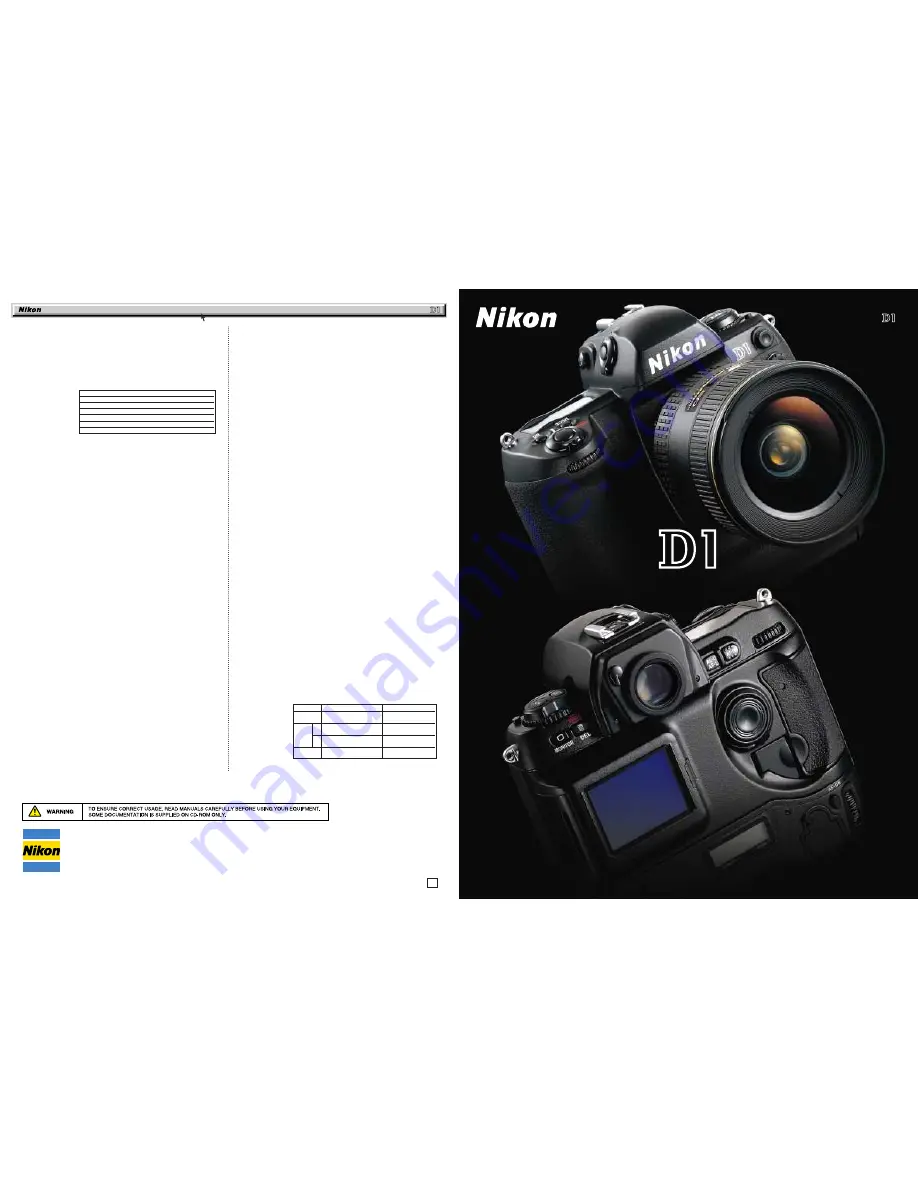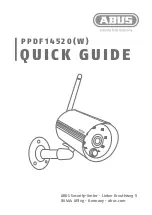
I t ’ s w h a t y o u
n e e d
. N o w .
Professional Digital SLR Camera
Printed in Japan Code No. 6CE41051 (9908-100)K
NIKON CORPORATION
FUJI BLDG., 2-3, MARUNOUCHI 3-CHOME, CHIYODA-KU, TOKYO 100-8331, JAPAN
http://www.klt.co.jp/Nikon
E
Microsoft
®
and Windows
®
are either registered trademarks or trademarks of Microsoft Corporation in the United States and/or other countries.
Macintosh
®
is a registered trademark or a trademark of Apple Computer Inc. in the United States and/or other countries.
Products and brand names are trademarks or registered trademarks of their respective companies.
Specifications and equipment are subject to change without any notice or obligation on the part of the manufacturer. August 1999 ©1999 NIKON CORPORATION
Type of Camera Lens-interchangeable SLR-type digital camera
CCD 23.7
x
15.6mm RGB CCD; 2.74 million total pixels;
2.66 million effective pixels (2,012
x
1,324 array); captures 12-bit full-color image
Image Size 2,000
x
1,312 pixels
Sensitivity ISO equivalency 200, 400, 800, 1,600
Storage System: Digitally stored; JPEG (approx. 1/4, 1/8, 1/16 compressed), uncompressed
(12-bit Raw
*
, 8-bit RGB-TIFF, 8-bit YCbCr-TIFF
*
), monochrome mode
* Optional software is needed to reproduce images; “Nikon Capture” for Raw/YCbCr-TIFF mode,
“Nikon View DX” for YCbCr-TIFF mode.
Media: CompactFlash
™
(CF) Card (Type I/II)
Modes and no. of frames (With EC-96CF 96MB CF Card):
Shooting Modes 1) Single frame shooting (S) mode: advances one frame for each shutter release;
capture preview mode and record & review mode available,
2) Continuous shooting (C) mode: approx. 4.5 frames per sec. (up to 21
consecutive shots
**
)
3) Self-timer (
V
) mode: time duration can be set,
4) Playback (PLAY) mode: playback, menu setting,
5) PC (PC) mode (data transfer mode): camera can be controlled from personal computer
** Up to 10 shots in Raw mode; the number of shots varies depending on the remaining capacity of the storage media.
White Balance 1) Auto (TTL control with 1,005-pixel CCD), 2) Manual (six settings with 7-step
fine tuning), 3) Preset
LCD Monitor 2-in., 114,000-dot, low temp. polysilicon TFT LCD; backlight/brightness
adjustment available
Playback Function 1) 1 frame, 2) Thumbnail (9 segments), 3) Slide show,
4) Histogram indication & highlight point display
Delete Function 1) Card format, 2) All frames delete, 3) Selected frames delete
Video Output NTSC or PAL (selectable)
Interface IEEE1394 (400Mbps)
Exposure Mode 1) [
¡
] Programmed Auto (Flexible Program possible),
2) [
™
] Shutter-Priority Auto,
3) [
£
] Aperture-Priority Auto,
4) [
¢
] Manual
Usable Lenses 1) D-type AF Nikkor: All functions possible,
2) D-type Nikkor other than AF: All functions except autofocus possible,
3) AF Nikkor other than D-type: All functions except 3D Color Matrix Metering
and 3D Multi-Sensor Balanced Fill-Flash for D1 possible,
4) AI-P Nikkor: All functions except 3D Color Matrix Metering,
3D Multi-Sensor Balanced Fill-Flash for D1 and autofocus possible,
5) Non-CPU: Usable in [
£
] or [
¢
] mode, Center-Weighted or Spot Metering;
Electronic Rangefinder usable with lens with maximum aperture of f/5.6 or faster
Note: When Non-CPU lenses are used, [
£
] mode is selected automatically for [
¡
] or [
™
] mode, also Center-Weighted
Metering is selected for 3D Color Matrix Metering.
Picture Angle Approx. 1.5
x
focal length in 35mm [135] format equivalent
Viewfinder Optical-type fixed-eye level pentaprism; built-in diopter adjustment (–3 to +1 DP);
eyepiece shutter provided
Eyepoint 22mm (at –1.0 DP)
Focusing Screen B-type BriteView clear Matte screen III; interchangeable with optional E-type
screen with grid for F100
Viewfinder Frame Coverage Approx. 96%
Viewfinder Magnification Approx. 0.8
x
with 50mm lens set to infinity and –1.0 DP
Viewfinder Information Focus indications, shutter speed, aperture, exposure mode, metering system,
shutter speed lock, aperture lock, AE lock, electronic analog display, frame counter,
ready-light, five sets of focus brackets (area)
Autofocus TTL phase detection, Nikon Multi-CAM1300 autofocus module; Detection range:
EV –1 to EV 19 (ISO 100 equivalent, at normal temperature)
Lens Servo 1) Single Servo (S) AF,
2) Continuous Servo (C) AF,
3) Manual focus (M); Focus Tracking automatically activated by subject’s status in
(S) or (C) AF
Focus Area One of five focus areas can be selected
AF Area Mode 1) Single Area AF and
2) Dynamic AF (Dynamic AF Mode with Closest Subject Priority is available)
Focus Lock Focus is locked by pressing
‚
button or lightly pressing shutter release button
in (S) AF
Exposure Metering Mode TTL full-aperture exposure metering system;
1) 3D Color Matrix Metering with 1,005-pixel CCD,
2) Center-Weighted Metering (75% of the meter’s sensitivity concentrated on the
8mm dia. circle),
3) Spot Metering (4mm dia. circle, approx. 2% of entire frame)
Exposure Metering Range 1) 3D Color Matrix Metering: EV 0-20,
2) Center-Weighted Metering: EV 0-20,
3) Spot Metering: EV 2-20 (at normal temperature, ISO 100 equivalent, f/1.4 lens)
Exposure Meter Coupling CPU and AI combined
Exposure Compensation Exposure compensated in ±5 EV range in 1/2 or 1/3 EV steps; the mark appears in
viewfinder information and top LCD panel
Auto Exposure Lock Detected exposure value locked by pressing
‚
button
Auto Exposure Bracketing Number of shots: two or three; compensation steps: 1/3, 1/2, 2/3 or 1 steps
Shutter Charge-coupled electronic and mechanical shutters
Shutter Speeds 30 to 1/16,000 sec. and Bulb
Sync Contact X-contact only; flash synchronization up to 1/500 sec.
Flash Control 1) Automatic Balanced Fill-Flash controlled by five-segment TTL Multi Sensor:
• 3D Multi-Sensor Balanced Fill-Flash for D1 when used with SB-28DX and
D-type Nikkor lens;
• Multi-Sensor Balanced Fill-Flash for D1 when used with SB-28DX and
AF Nikkor other than D-type, AI-P Nikkor lens,
2) AA (Auto Aperture)-type Flash available when used with SB-28DX and Nikkor
lens with built-in CPU,
3) Non-TTL Auto Flash with a Speedlight such as SB-28DX, 28, 27, 22s, etc.
Flash Sync Mode 1) Front-Curtain Sync (normal sync), 2) Red-Eye Reduction,
3) Red-Eye Reduction with Slow Sync, 4) Slow Sync, 5) Rear-Curtain Sync
Ready-light Lights up when flash fully charged with Speedlight SB-28DX, 28, 27, 22s; blinks
(3 sec. after flash) for full output warning
Accessory Shoe Standard ISO-type hot-shoe contact; safety lock provided
Sync Terminal Standard JIS terminal, lock screw provided
Self-timer Electronically controlled; timer duration: 2-20 sec.
Depth-of-field Preview Button Stop-down lens aperture by pressing depth-of-field preview button
Remote Control Via 10-pin remote terminal, IEEE1394 interface (400Mbps)
Power Requirements Ni-MH Battery Pack EN-4 (7.2V DC), Quick Charger MH-16/15, EH-3;
AC Adapter EH-4 (100-240V AC)
Custom Settings #0] Custom settings: Specify the two setting combinations of A and B,
#1] Image status: 1) No indication, 2) Capture preview, 3) Record & review,
#2] EV steps for exposure control, #3] Bracketing order, #4] Autofocus activation,
#5] Anti-Vibration mode: Delays exposure until mirror shock has subsided,
#6] Focus area selection, #7] AE lock, #8] Mirror-Up: Set to clean the CCD,
#9] Dynamic AF mode in (S) AF, #10] Dynamic AF mode in (C) AF,
#11] Auto Exposure/Flash Exposure Bracketing,
#12] Command Dial functions, #13] Exposure compensation settings,
#14] Center-Weighted Metering area: Change 8mm dia. circle to 6, 10, 13mm or
average metering,
#15] Time delay for auto meter-switch-off, #16] Self-timer duration,
#17] LCD illumination, #18] Auto power off of LCD Monitor: 20 sec., 1, 5 or 10 min.,
#19] Aperture setting,
#20] Shutter release indication via self-timer LED, #21] AE-L/AF-L button,
#22] Aperture selection: Change via Sub-Command Dial to lens’ aperture ring,
#23] Sharpening: 1) Normal, 2) Low, 3) High, 4) None,
#24] Tone compensation: 1) Auto, 2) Normal, 3) Contrast -, 4) Co,
5) Custom (with “Nikon Capture” Control Software),
#25] Shooting speed in (C) mode: Choose from 4.5, 3, 2, 1 fps. or CL,
#26] Maximum number of consecutive shots in (C) mode: 1 to 21 shots,
#27] LCD monitor display mode: 1) Default, 2) Histogram, 3) Highlight point,
4) Highlight point with Histogram,
#28] Save Raw images, #29] Auto File Numbering mode,
#30] Select shooting mode when disconnected from personal computer
in (PC) mode: (S) mode or (C) mode
#31] Sensitivity up: Can be increased in approx. +1 or +2 steps from ISO 1,600
equivalency
Dimensions (W
x
H
x
D) Approx. 157
x
153
x
85mm (6.2
x
6.1
x
3.4 in.)
Weight (without battery) Approx. 1.1kg (2.5 lbs.)
Standard Accessories
***
Video Cable, Neck Strap, Body Cap BF-1A, Monitor Cover
Optional Accessories Ni-MH Battery Pack EN-4, Quick Charger MH-16, AC Adapter EH-4,
CompactFlash
™
Cards EC-64CF (64MB)/EC-96CF (96MB), IEEE1394 Cable
SC-D1, Speedlight SB-28DX, Antifog Finder Eyepiece DK-14/15,
“Nikon View DX” Browser Software, “Nikon Capture” Control Software
*** Standard accessories may differ in each country or area.
Optional Software
System Requirements
*1 “Nikon View DX” Browser Software *2 “Nikon Capture” Control Software
For Windows
®
For Macintosh
®
OS
Microsoft
®
Windows
®
95,
Mac
®
OS 8.6 or later
Windows
®
98, Windows
®
NT 4.0
(CPU: Power PC
™
G3 or later)
Memory
V
*1
16MB minimum
16MB minimum
(over 32MB recommended)
(over 32MB recommended)
C
*2
64MB minimum
32MB minimum
(over 128MB recommended)
(over 48MB recommended)
IEEE1394
Adaptec
®
AHA-8920/8945,
1394 board installed in G3
HotConnect V1.1 or later
or Adaptec
®
AHA-8945
Image quality mode
EC-96CF 96MB CF Card
Raw (uncompressed Raw)
Approx. 23
Hi (uncompressed YCbCr-TIFF)
Approx. 18
Hi (uncompressed RGB-TIFF)
Approx. 12
Fine (approx. 1/4 compressed)
Approx. 66
Normal (approx. 1/8 compressed)
Approx. 132
Basic (approx. 1/16 compressed)
Approx. 265
Nikon Professional Digital SLR Camera D1 Specifications






















